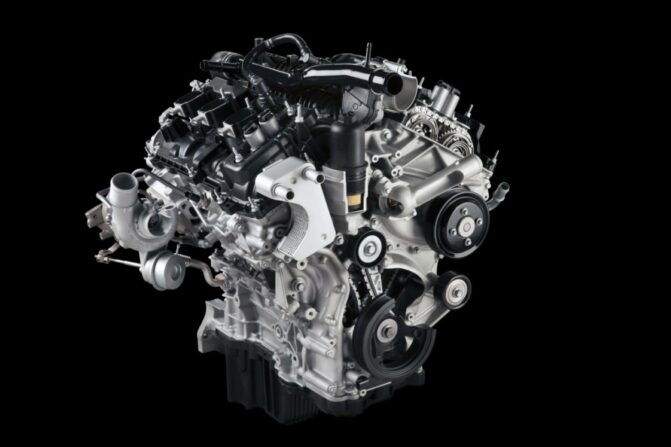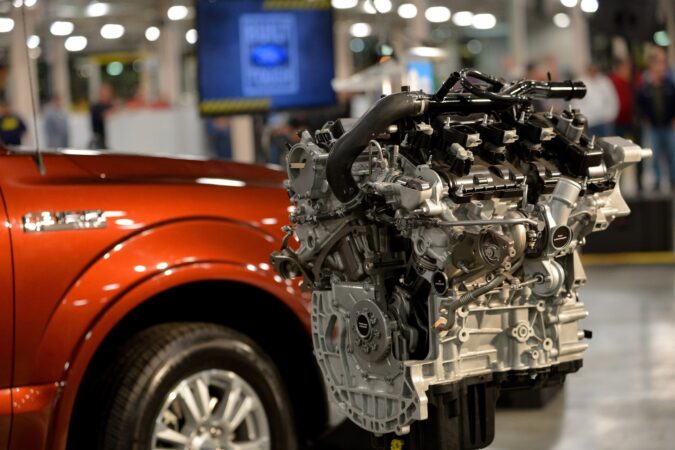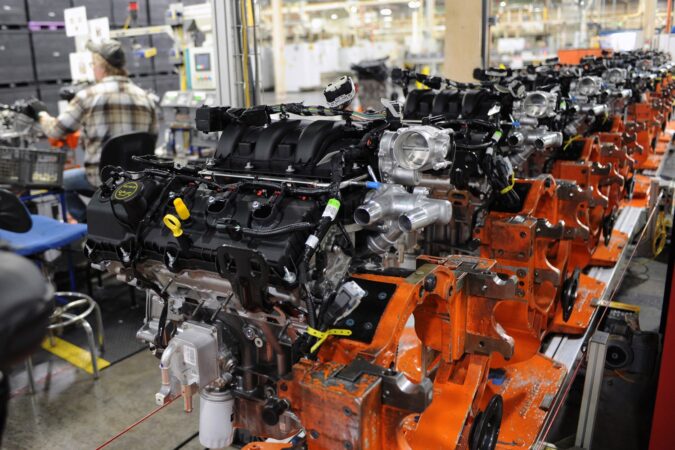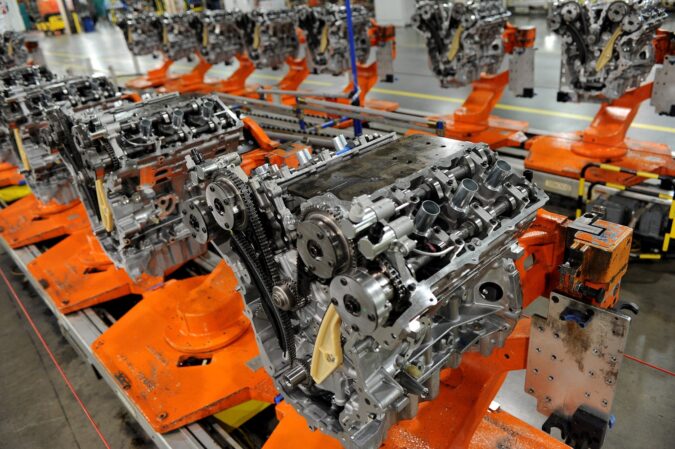The Ford F150 has been the best-selling pickup for the past several decades, and there’s a bit of F150 for pretty much everyone. From sporty Raptors to the uber-luxurious King Ranch, and the workhorse XL trim, powering such a diverse range of trucks meant that Ford had to create multiple engines. But, which of these is the most reliable (and best) Ford F150 engine?
What Are Some Of The Engines That Powered The F150?
But, before we discuss the reliability of each Ford F150 engine to see which is the best (and most reliable Ford F150 engine option), here’s a rundown of the many engines that Ford makes, just for the F150 pickup truck:
- 3.3-liter Cyclone V6 (could run on flex fuel, available in the XL and XLT trims)
- 2.7-liter EcoBoost twin-turbo V6 (the base engine on almost all F150 trims)
- 3.5-liter EcoBoost twin-turbo V6 (an optional, performance engine in the Lariat trim and up)
- 3.5-liter PowerBoost twin-turbo V6 hybrid (available as an option in the Platinum and Limited trims)
- 5.0-liter Coyote V8 (an optional engine available on most trims)
The aforementioned engines are currently available on the current-gen Ford F150 (which we’ll mainly focus on when assessing their reliability). However, there were a few other noteworthy Ford F150 engines that were discontinued, and used in older model years of the F150:
- 3.0-liter Power Stroke turbo-diesel V6 (discontinued in 2021 due to poor sales)
- 4.6-liter Triton V8 (available in various trims from the late 90s to 2010, now replaced by the Coyote V8)
- 5.8-liter Triton V8 (available in various trims from the late 90s to 2010, now replaced by the Coyote V8)
- 5.0-liter small-block V8
- 5.8-liter Windsor V8
- … And a lot more engines in older or niche trims and variants of the F150, which we won’t be focusing on today.
Which Ford F150 Truck Engine Is The Most Reliable?
With that being said, among all these engines, the most reliable Ford F150 engine options are the 2.7-liter EcoBoost, 3.5-liter EcoBoost, 3.5-liter PowerBoost, and the 5.0 Coyote V8, so here’s a quick rundown…
1. 3.5-Liter EcoBoost V6
The first of the most reliable F150 engine options, and we think the best all-rounder, is the 3.5-liter EcoBoost V6. Available from the 2011 model of the F150, this engine initially made a very healthy 365 horsepower and 420lb-ft of torque. Ford then introduced the second generation (D35) in 2017, now with a power output of 400 horsepower and 500lb-ft of torque.
This D35 variant puts it on par with the 5.0L Coyote V8 in terms of horsepower and makes 90lb-ft more torque. It also gets better mileage than the Coyote, albeit slightly. The Coyote is rated for around 17mpg in the city and 21mpg highway. Meanwhile, the EcoBoost gets 19mpg city and 22mpg highway. Not a big difference, but every bit of fuel saving matters.
Also, if you require heavier towing capacities, the second-generation 3.5L EcoBoost can tow up to 14,000 lbs. That’s a solid 1,000 lbs more than the 5.0 Coyote can tow. However, the first generation can only tow up to about 8,600 lbs, so keep that in mind. Now, as far as reliability is concerned, no matter how reliable an engine is, it’s bound to have issues.
So, when we say that an engine is reliable, it simply means that its problems are negligible or not systemic. These are either easy and cheap to fix, and/or easily avoidable with some preventive maintenance. Or, these issues aren’t reflective of inherent design flaws. That said, here are some of the more common 3.5L EcoBoost V6 issues:
Most Common 3.5 EcoBoost Problems
- Carbon buildup in the intake valve is a common issue in direct injection engines, including the EcoBoost. Walnut blasting the intake ports every 70,000 to 100,000 miles is a good idea to avoid future problems.
- Timing chain issues. The first-generation 3.5 EcoBoost engine was prone to a timing chain failure. And replacing the timing chain assembly is necessary which can cost up to $1,200.
- Spark plugs and ignition coils are likely to fail at around 40,000 to 60,000 miles. Whereas most other cars typically require a change every 70,000 miles. Not a big issue, but worth noting.
Note that the carbon buildup and timing chain issues are only present in the first-generation engine. The later, second-generation D35 EcoBoost has a combination of port and direct injection, reducing carbon buildup in the intake valve and you won’t need to clean it as often.
Ford has also resolved the timing chain issue in the second-generation engine by using two timing chain systems (one for each bank) instead of just one. This means the timing chain is shorter, and Ford has strengthened it by making it thicker. Thus, reducing the possibility of a stretching timing chain.
2. 5.0-Liter Coyote V8
The 5.0-liter Coyote V8 is the same engine that you’ll find in the 5.0 Mustang GT. There are minor differences, such as the intake manifold, camshaft, and compression. This results in the F150’s Coyote having slightly less horsepower, but more torque – what you need in a big truck. It does seem rather pointless due to the 3.5L EcoBoost being around, though.
Power is the same, and it offers less torque now. However, V8 engines have a certain charm to them. There’s something about that V8 grunt and rumble that V6 engines just can’t replicate. And of course, as they say, no replacement for displacement. Additionally, we know that the Coyote V8 still has more towing capacity than the EcoBoost engine, generally.
But as mentioned, towing capacity depends on the trim. We recommend consulting with a Ford dealer for more details. Anyway, the 5.0L Coyote V8 is a fantastic engine that has very few reliability issues. If you need the towing power, or you just want a V8 in your truck, the Coyote V8 is a fantastic engine. All in all, it’s a great alternative to the EcoBoost.
However, as with the 3.5-liter EcoBoost V6 from earlier, the 5.0-liter Coyote V8 isn’t free of problems. Again, just like the EcoBoost V6, most of these issues aren’t terribly systemic or indicative of major flaws with the Coyote V8. But, quite a handful of owners have documented these issues, so here’s what you need to look out for with the Coyote V8:
Most Common 5.0 Coyote Problems
- Rough running and sudden stalling. The problem stems from a faulty throttle body.
- Rattling noise is also a reported issue in the Coyote V8. This is due to a design flaw in the timing chain assembly.
- Coolant leak due to a defective T-connector in the cooling system lines.
Some issues are isolated to certain model years, mainly the 2016 and 2016 model years. But overall, the Coyote is a very reliable engine with very few widespread issues to worry about. The one issue that seems to persist is the engine rattle which comes from the timing chain. While rattling noises aren’t pleasant, Ford claims that it isn’t a cause for concern.
Additionally, they’ve issued several Technical Service Bulletins (TSB) to resolve this issue. So, there’s no recall, but Ford technicians can resolve this issue. If your F150 suffers from rattling noises and is still under warranty, you should take it to the dealership and have them inspect the problem. So, if a V8’s more your thing, the Coyote is generally quite reliable.
3. 2.7-Liter EcoBoost V6
Ford offers the 2.7L EcoBoost V6 as the base engine in several F150 trims. It’s also a twin-turbo V6, and since it’s part of the EcoBoost engine family, it shares largely the same architecture with the 3.5L EcoBoost. And yes, it’s a very reliable engine as well. However, it “only” makes 325 horsepower and 375lb-ft of torque in its 1st-generation (2015 – 2017).
And 400lb-ft of torque in the second generation version (2018 – present). While this is a respectable output, it might not be enough for a truck as big as the F150. Sure, it’s rated for 20mpg city and 26mpg highway, a lot more than the 3.5L EcoBoost. But once you tow heavy loads, you might end up using more fuel since you’ll need to mash the gas pedal harder.
Speaking of which, depending on the configuration, the 2.7L EcoBoost can only tow up to 10,000 lbs. So, the 2.7L EcoBoost is also a great and reliable engine, with minimal system faults. But if you have the cash to spare, we recommend getting the 3.5L EcoBoost instead as it offers more power and is overall a better fit for a full-size truck like the Ford F150.
4. 3.5-Liter PowerBoost V6 Hybrid
The 3.5L PowerBoost is the hybrid variant of the 3.5L EcoBoost engine. It’s a mild hybrid configuration, meaning that the engine charges the battery, which then powers the electric motor. So, you can’t plug it in. However, the burst of electric power can reduce gas consumption. The EPA estimates that it will do about 24mpg city and 27mpg highway.
Not a big boost, but still pretty impressive for a full-size truck. On the power side, the PowerBoost has a total of 430 horsepower and 570lb-ft. Slightly more than the EcoBoost, but the tow rating is lower thanks to the extra weight of the hybrid drivetrain. Again, this varies depending on configuration, but the PowerBoost will only be able to tow up to 12,700 lbs.
Another thing to keep in mind is that this powertrain has only been around for about a year now. So, while the engine is likely going to be reliable, there’s no guarantee the hybrid powertrain will be as reliable. And of course, replacing the battery won’t be cheap. If you want a full-size truck that doesn’t use much gas, the PowerBoost is a great option.
But there’s an asterisk about it being one of the most reliable F150 engine options, specifically with the hybrid. For the time being, however, owners have good things to say about it. While it is more complex, given how much it shares with the 3.5 EcoBoost, much of the reliability and refinement may carry over. Though, we’ll keep you posted as more data comes through.




